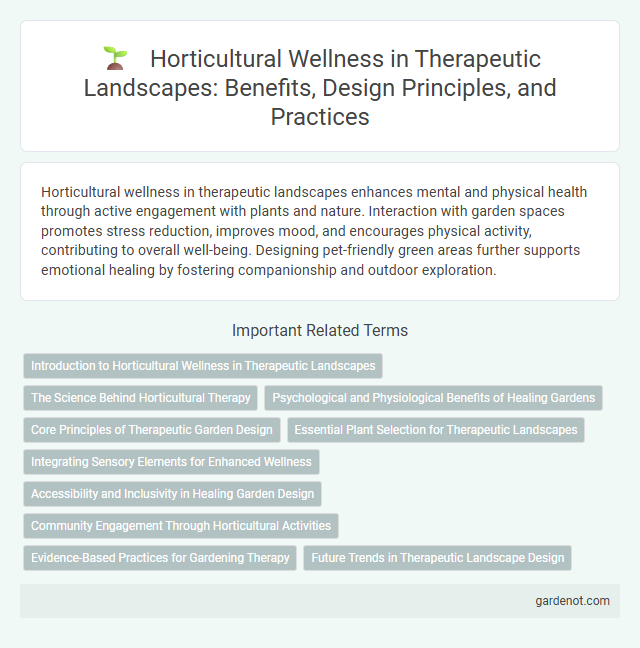Horticultural wellness in therapeutic landscapes enhances mental and physical health through active engagement with plants and nature. Interaction with garden spaces promotes stress reduction, improves mood, and encourages physical activity, contributing to overall well-being. Designing pet-friendly green areas further supports emotional healing by fostering companionship and outdoor exploration.
Introduction to Horticultural Wellness in Therapeutic Landscapes
Horticultural wellness in therapeutic landscapes emphasizes the integration of plant cultivation and nature-based activities to promote physical, mental, and emotional health. Incorporating gardens with diverse plant species enhances sensory stimulation, reduces stress, and supports rehabilitation processes in healthcare settings. Evidence shows that exposure to green spaces in therapeutic gardens significantly improves patient outcomes and overall well-being.
The Science Behind Horticultural Therapy
Horticultural therapy leverages the therapeutic benefits of plant cultivation and garden-based activities to improve mental, emotional, and physical health. Research demonstrates that engagement with horticultural environments reduces cortisol levels, enhances mood regulation, and promotes neuroplasticity through sensory stimulation and purposeful tasks. Clinical studies confirm that horticultural therapy facilitates recovery in patients with depression, anxiety, PTSD, and cognitive decline by combining nature exposure with structured therapeutic interventions.
Psychological and Physiological Benefits of Healing Gardens
Healing gardens promote horticultural wellness by reducing stress, anxiety, and depression through exposure to natural environments that stimulate sensory engagement. Studies reveal significant physiological benefits such as lowered blood pressure, improved immune function, and enhanced cardiovascular health in individuals regularly interacting with therapeutic landscapes. These psychological and physiological effects underscore the critical role of healing gardens in integrative healthcare and mental well-being.
Core Principles of Therapeutic Garden Design
Horticultural wellness thrives on the core principles of therapeutic garden design, which emphasize sensory engagement, accessibility, and restorative environments. Incorporating diverse plant species, varying textures, and calming colors supports mental health and physical rehabilitation. Thoughtful spatial planning, including paths, seating, and shade, enhances user comfort and encourages prolonged interaction with nature.
Essential Plant Selection for Therapeutic Landscapes
Selecting essential plants for therapeutic landscapes involves prioritizing species with proven mental and physical health benefits, such as lavender for its calming properties and aloe vera for skin healing. Incorporating diverse plant varieties that stimulate the senses--through color, scent, and texture--enhances horticultural wellness and supports patient recovery. Native plants adapted to local climates increase sustainability and resilience, ensuring long-term therapeutic effectiveness.
Integrating Sensory Elements for Enhanced Wellness
Integrating sensory elements such as scent, texture, and color within horticultural wellness spaces enhances therapeutic landscapes by stimulating multiple senses, promoting relaxation, and reducing stress. Plants like lavender and rosemary not only provide fragrant aromas but also offer tactile engagement, which improves mental well-being and supports mindfulness practices. Incorporating these multisensory components creates immersive environments that foster healing and elevate overall wellness outcomes.
Accessibility and Inclusivity in Healing Garden Design
Healing garden design prioritizes accessibility and inclusivity by incorporating wheelchair-friendly pathways, raised garden beds, and sensory-rich plant selections to accommodate diverse physical and cognitive abilities. Incorporating universal design principles ensures therapeutic landscapes serve individuals with mobility impairments, visual or auditory sensitivities, and varying therapeutic needs. These inclusive horticultural wellness environments promote social interaction, mental restoration, and physical rehabilitation for all users.
Community Engagement Through Horticultural Activities
Horticultural wellness enhances therapeutic landscapes by fostering community engagement through shared gardening projects and plant cultivation activities. These communal green spaces promote social interaction, mental health, and environmental stewardship, creating a supportive environment for holistic well-being. Participation in horticultural initiatives strengthens community bonds and encourages sustainable practices that benefit both individuals and urban ecosystems.
Evidence-Based Practices for Gardening Therapy
Gardening therapy utilizes horticultural activities to improve mental health, supported by evidence-based practices that demonstrate reductions in stress, anxiety, and depression. Structured programs incorporating plant care, soil interaction, and garden design have shown measurable improvements in cognitive function and emotional well-being. Research from institutions such as the American Horticultural Therapy Association highlights standardized protocols enhancing therapeutic outcomes in diverse populations.
Future Trends in Therapeutic Landscape Design
Horticultural wellness in therapeutic landscape design is shifting towards integrating biophilic elements with smart technology to enhance personalized healing experiences. Future trends emphasize sustainable planting schemes, adaptive green infrastructures, and immersive sensory gardens that promote mental restoration and physical rehabilitation. Advances in plant science and environmental psychology drive innovative landscapes that respond dynamically to user needs and climatic changes.
Horticultural wellness Infographic

 gardenot.com
gardenot.com